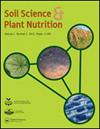大豆幼苗至成虫营养期根系对低磷速效的响应
IF 1.8
4区 农林科学
Q3 ENVIRONMENTAL SCIENCES
引用次数: 3
摘要
由于全球磷资源的迅速枯竭,需要高效磷作物。本研究利用从世界各地收集的多种大豆基因型,研究了其根部在子叶出苗(VE)、单叶出苗(VC)和三叶第四小叶出苗(V4)生长阶段对低磷条件的形态生理响应。首先,比较了81个大豆基因型在VC期不同施磷条件下的生长情况。大多数基因型根系形态在不同磷胁迫条件下无显著差异。然而,GmWMC138在VC期低磷条件下表现出根重增加的特点,因此,我们选择GmWMC138与种子重相似的基因型进行进一步的比较分析。比较了4个选择的基因型在VE期和VC期的种子贮藏磷含量、植物生长、植酸酶和酸性磷酸酶活性对低磷条件的响应。与其他基因型相比,低磷条件对GmWMC138 VE和VC期无机磷(Pi)水平和茎部生长的影响较小。该基因型在低磷条件下,VC期根系鲜重、VE期根系植酸酶活性和VC期根系酸性磷酸酶活性均有所增加。这些酶活性的差异可能导致了低磷条件下VC期根系Pi含量的维持和根系鲜重的增加。此外,还比较了不同基因型水稻V4期生长和磷含量对低磷的响应。与正常施磷相比,GmWMC138在低磷条件下细根长度增加,总磷含量保持不变。这些结果表明,大豆幼体生育阶段(如VE期和VC期)根系在低磷条件下的形态变化可能有助于后续生育阶段(如V4期)对缺磷的耐受。本文章由计算机程序翻译,如有差异,请以英文原文为准。
Root response of soybean genotypes to low phosphorus availability from juvenile to adult vegetative stages
ABSTRACT Due to the rapid exhaustion of global phosphorus (P) resources, P-efficient crops are required. In this study, we used various soybean genotypes collected from around the world and investigated the morphophysiological responses of their roots to low-P conditions at the cotyledon emergence (VE), unifoliate leaves emergence (VC), and fourth trifoliate leaflet emergence (V4) growth stages. First, we compared the growth of 81 soybean genotypes under different P conditions at the VC stage. The root morphology of most genotypes did not differ according to P conditions. However, GmWMC138 showed increased root weight under low-P conditions at the VC stage, and was therefore selected for further comparative analysis with genotypes with similar seed weights. Four selected genotypes were compared in terms of their seed storage P content and responses of plant growth and phytase and acid phosphatase activities to low-P conditions at the VE and VC stages. The inorganic-P (Pi) levels and shoot growth at the VE and VC stages of GmWMC138 were less affected by low-P conditions compared to the other genotypes. In this genotype, root fresh weight at the VC stage, phytase activity in roots at the VE stage, and acid phosphatase activity in roots at the VC stage increased under low-P conditions. The differences in these enzyme activities may have led to the maintenance of root Pi content and subsequent increase in the root fresh weight at the VC stage under low-P conditions. In addition, the low-P responses of growth and P content at the V4 stage were compared among the selected genotypes. In GmWMC138, fine-root length increased and total P content was maintained under low-P conditions compared to normal-P conditions. These results imply that in soybeans morphological changes in roots in response to low-P conditions at juvenile growth stages, such as the VE and VC stages, may contribute to P-deficiency tolerance in subsequent growth stages, such as the V4 stage.
求助全文
通过发布文献求助,成功后即可免费获取论文全文。
去求助
来源期刊

Soil Science and Plant Nutrition
农林科学-农艺学
CiteScore
4.80
自引率
15.00%
发文量
56
审稿时长
18-36 weeks
期刊介绍:
Soil Science and Plant Nutrition is the official English journal of the Japanese Society of Soil Science and Plant Nutrition (JSSSPN), and publishes original research and reviews in soil physics, chemistry and mineralogy; soil biology; plant nutrition; soil genesis, classification and survey; soil fertility; fertilizers and soil amendments; environment; socio cultural soil science. The Journal publishes full length papers, short papers, and reviews.
 求助内容:
求助内容: 应助结果提醒方式:
应助结果提醒方式:


